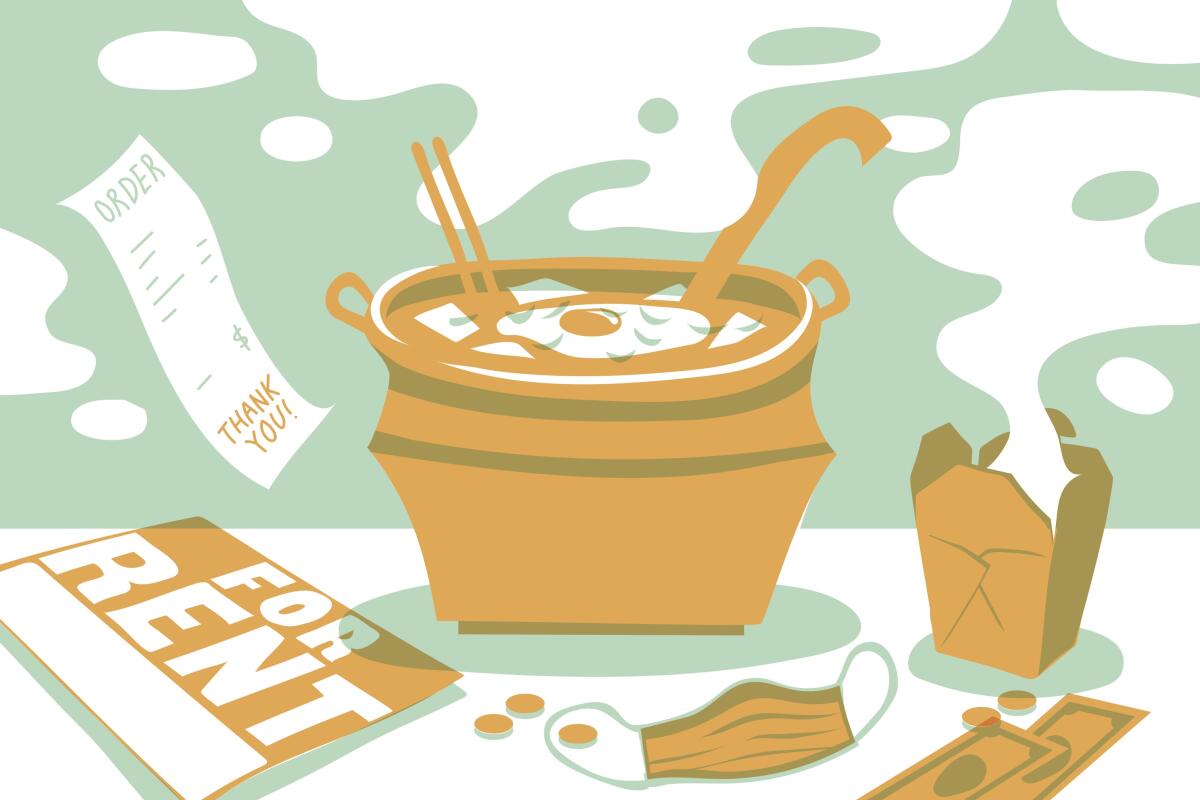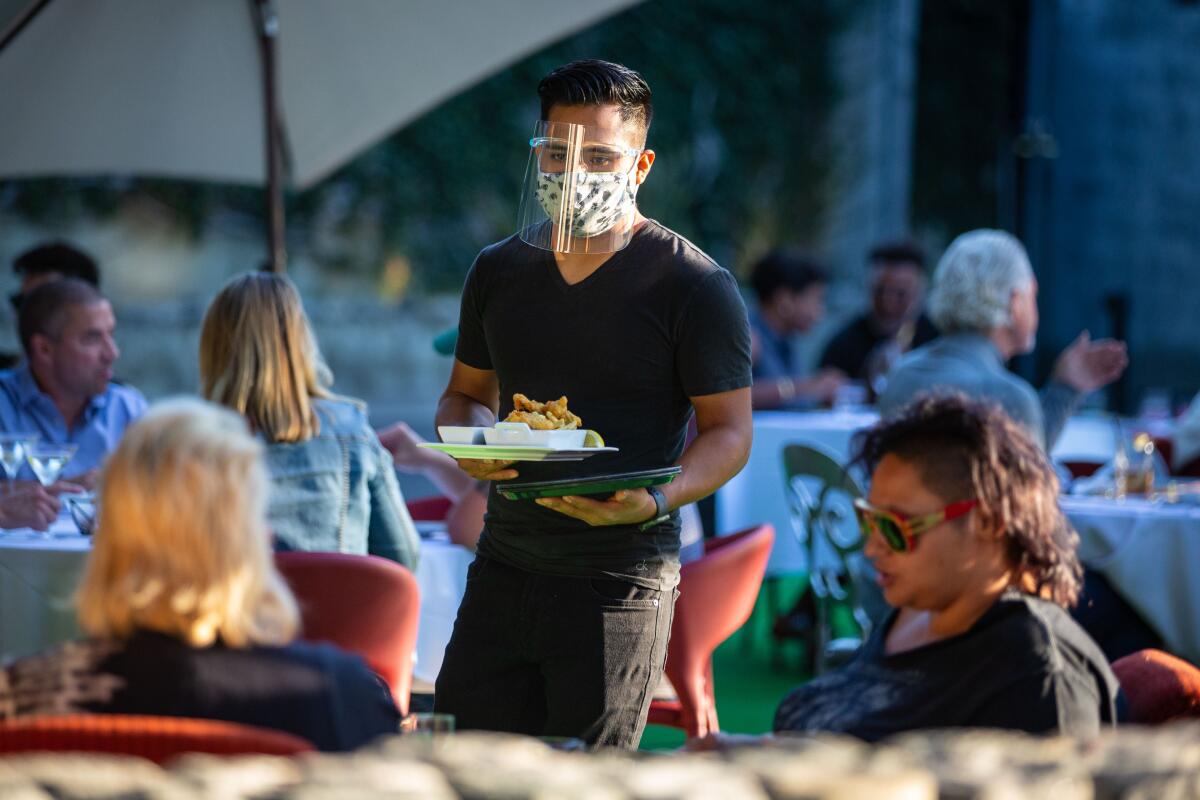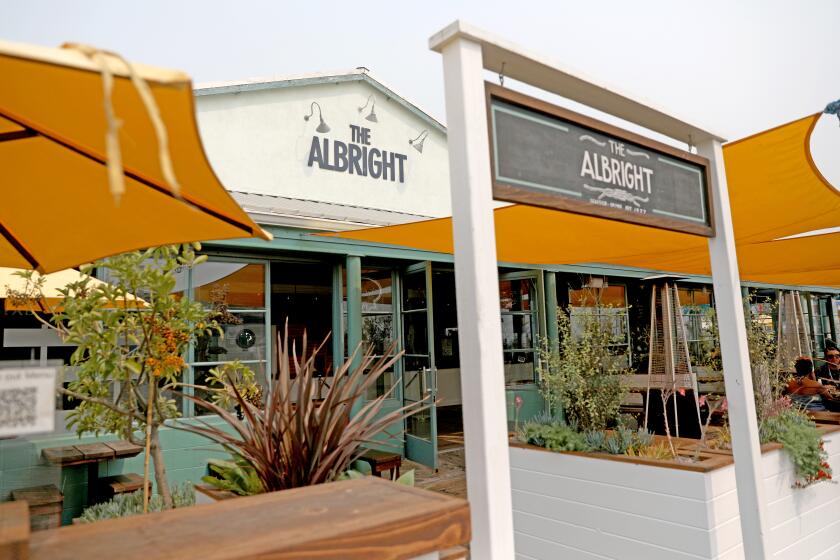Razed and exposed, the restaurant industry is due for change

- Share via
Monica Lee opened Beverly Soon Tofu in 1986, and over three decades it became one of Koreatown’s bedrocks for nourishment. But earlier this month, the tofu house announced on Instagram that it was closing permanently as of Sept. 20 — yet another loss in the restaurant community stemming from the COVID-19 catastrophe.
The last time I ate there was shortly after moving to Los Angeles, late in the fall of 2018. I’d enjoyed meals there previously when I was Eater’s national critic and traveled frequently to Southern California. The restaurant came to mind as I was settling in as a new resident; it was a drizzly December night and I felt a cold coming on.
Beverly Soon Tofu’s 40-seat dining room wasn’t quite full that evening. A server waved me toward a table next to a jagged redwood sculpture that ran across one wall. Its patterns, especially when viewed from a bit of distance, looked like leaping flames.
A mounted TV flashed pictures of dishes: galbi, bulgogi, tofu steak. I wanted what most everyone ordered: soondubu jjigae, the stew of soft tofu, its broth crimson from ground chiles, served boiling in individual ceramic pots. Lee’s menu listed options of different seafoods and meats to include in the soondubu, as well as mix-and-match combinations of the soup with grilled meats or bibimbap. Her format inspired similar tofu houses across the United States.
I didn’t wait long for my soondubu. The server splayed out white bowls filled with banchan: two kinds of kimchi (the inner leaves of cabbage and another dish of cubed daikon), sprouts with squiggly crunch and a vinegary cucumber salad. Then the stew arrived, erupting and spitting. I did the predictable food writer thing: I took video of the soup as it simmered frantically, even as the lens of my phone camera fogged over. The server rolled her eyes and cracked an egg into the soup for me. I stirred it in quickly and then began fishing out oysters and clams (I’d asked for the seafood combination; mussels and shrimp also lurked) before they turned to rubber in the intense heat.
In my memory, Lee’s soondubu stewed the chills right out of me; I woke up feeling better the next day. If only there were such a soothing curative for the country’s more insidious maladies.
Writing restaurant elegies could be full-time work these days. Six months into coronavirus-related shutdowns, every publication that covers Los Angeles dining culture maintains a running list of ongoing restaurant closures. No genre has been spared — not tasting menu restaurants from famous chefs, not tiny neighborhood institutions, not steakhouse chains. It can take a force of will not to glaze over with numbness, to instead stay present for the vanishing of jobs and creativity and community sustenance. I’ve read varying estimates saying that, by the time the coronavirus threat has passed, somewhere between 20% and 75% of restaurants will have permanently closed. No oracle can accurately forecast a number.
What happens when a restaurant can’t pay the rent? What’s happening in Los Angeles, what options the restaurants have and what the experts say.
The suffering has been horrific, full stop. The story of the 2020 restaurant crisis, though, is as much about a call to action from its inner ranks as it is about the effects of the pandemic. Out of the misery, the immobility and the social reckoning sparked by the killings of George Floyd, Breonna Taylor and others, big questions long simmering in the American restaurant culture have surfaced, and they are impossible to skim away.
Many of the questions stem from the inherent brokenness of the restaurant model in America. Our government provides no safety nets for the low-wage, often undocumented workers upon whose labor the industry runs. A bio-network of businesses — farmers, meat and fish suppliers, wine and spirits makers and distributors, architects, linen services — begins to collapse when restaurants can’t feed customers to capacity, or when restaurants close altogether.
Much of the conversation in food media these days centers on the soldierly brigade system on which restaurant hierarchies have long been established and perpetuated; it’s a system that enables abuse from high-up-the-command-chain chefs who yell and belittle and harass their way through the nightly pressure cooker of kitchen life. Servers rely on tipping, a wage system rooted in racism that also encourages sexism and mistreatment.
Where can changes begin? With true universal healthcare, and with more effective government legislation that supports independent restaurants and small-scale agriculture? How do restaurant owners create more sustainable models of success? Would customers be willing to shell out more for meals if they understood they also were paying for more equitable incomes for those who prepare and serve their food? How do restaurants support their employees while also remaining affordable for their communities?
And in a society rife with wealth inequality, how much of the public even cares about these larger issues? I drive the streets of Los Angeles and marvel at the crowds I see dining along the sidewalk. It’s a complicated sight. Part of me cheers for restaurants acclimating to survive. The safety of restaurant workers has to be a priority. But without government aid, they also need livelihoods.

People want to eat out for many reasons. Dining, even during a pandemic, retains its cultural currency. Preorders for exquisite bentos from temples like n/naka and Hayato sell out the moment they’re posted online. Evan Funke, whose Felix in Venice was perpetually booked pre-pandemic, opened a six-month pop-up in Hollywood last month called Fingers Crossed; its popularity is so instant that no reservations are available until early October.
Some of us want to gather at a restaurant — any kind of restaurant — to grasp at rituals that might restore a sense of normalcy. Isolation will never really come to feel natural.
Meanwhile, according to the Los Angeles Regional Food Bank, one in five residents of Los Angeles County faces food insecurity — their access to food is uncertain enough that they don’t know the source of their next meal.
How do we effectively hold all this? The demand for luxury and the desire to support restaurants we love, while recognizing that many Angelenos live with hunger?
Questions outnumber the answers. Since the March shutdown, the Food section has run stories on the struggles of undocumented workers, the strategies that restaurants have adopted (selling groceries, pivoting entirely to takeout, turning parking lots into dining rooms) to meet the ever-changing moment, and the ways that organizations are feeding unemployed restaurant workers. We’ve spotlighted chefs who turned to Instagram to build an audience for the uplifting, often personal cooking they’re creating outside the traditional restaurant paradigm.
It’s part of a recalculation happening in food journalism examining the habitual mythologizing of media-crowned chefs whose worth overshadows the contributions of their team.
“White male chefs who already fit neatly into the stereotype of the auteur are overrepresented, praised for a highly specific approach to fine dining, then rewarded with more investment and opportunities to replicate that same approach,” Tejal Rao wrote in the New York Times, addressing the notion of the chef-auteur.
My colleague Lucas Kwan Peterson recently published a series of columns examining the illusions of auteurship and the intricacies of who gets credit for conceiving menu dishes. “We may not ever do away with … celebrity culture, or get to a place where restaurants and chefs are reviewed — and rewarded — based on how happy their employees are and the positive change they effect in their communities,” wrote Peterson. “But maybe, the rot that seems to have infected the food world of late is just on the surface. Maybe it can be scraped off, and we’ll find there’s something delicious underneath.”
It’s all a lot. In the thick of so much upheaval, I’ve also been thinking about standout Los Angeles chefs who have stayed quiet — those who’ve yet to reopen but haven’t announced permanent closures. Mei Lin is one of them: Her Nightshade in the Arts District, with sensations like the mapo tofu lasagna and mind-bending desserts from opening pastry chef Max Boonthanakit, was one of 2019’s most exciting new restaurants.
This fall she’s opening a fried chicken sandwich shop called Daybird; the food will be conceived with takeout in mind. As for reopening Nightshade, which was designed as a more formal, sit-down experience? “At the end of the day the staff is very much like family,” Lin said. “And so I ask myself, would I feel comfortable about one of my family members working out there right now, coming in direct contact with that many customers and putting themselves at risk — for any amount of money? I know everyone’s situation is different, but I guess I’m a bit protective when it comes to that.”
I asked her about the big questions at hand for the restaurant industry, about what she sees that needs to be rebuilt from the ground up. “I don’t have as much a problem with the brigade system itself as I do with the militant leadership tactics and attitude that seem to come with it,” she said. “I think during this period it’s become clearer to everyone that the old ways that chefs in my generation were taught are just not effective anymore. I’ve learned firsthand that the cycle of negative feedback, rule by fear and authority-for-authority’s-sake leadership just isn’t sustainable and doesn’t get the best out of team members.
“On the other hand,” Lin said, “we have the experience, the data and the grit to adapt — and no generation of chefs is better equipped to break this cycle than ours.”
As is richly apparent in the United States, there are rarely quick fixes to systemic failings. Transformation takes fortitude; the revolution, in the restaurant industry and the media that covers it, will require leadership and resources, particularly as we all continue to process the ongoing calamity.
If one can find any positivity in 2020, it’s this: The inherent flaws in the American restaurant industry model (and how the media covers it) have been decried so widely and loudly this year that it seems all but impossible for its players to go back to “business as normal.” The form and delineations of change may not have yet crystallized, but its essence is animate.
More to Read
Eat your way across L.A.
Get our weekly Tasting Notes newsletter for reviews, news and more.
You may occasionally receive promotional content from the Los Angeles Times.












